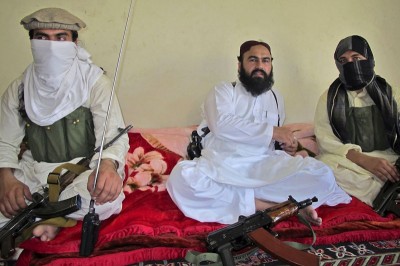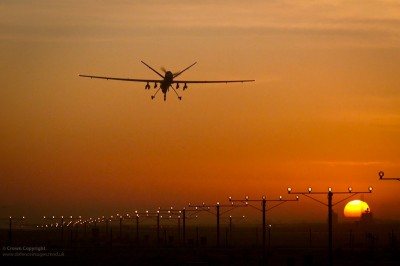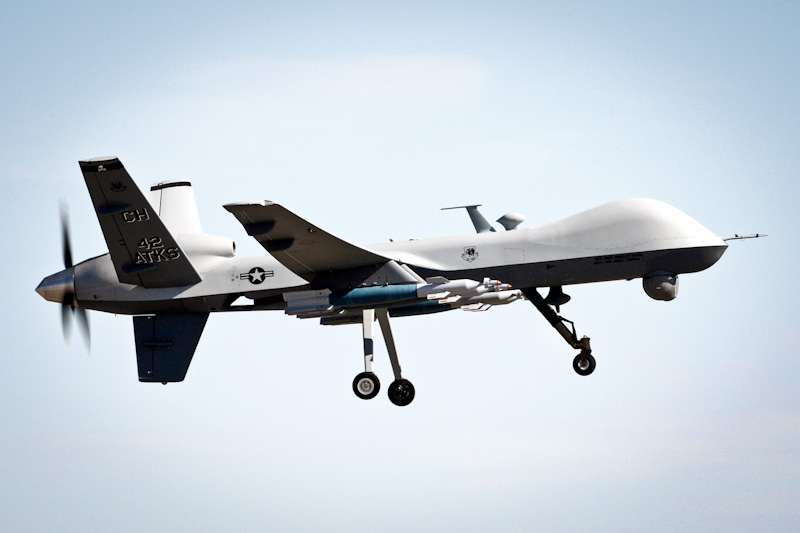The political tide in the US is turning away from drone strikes, as it did long ago in Pakistan. But are we giving up our best tool for fighting terror?
It didn’t take long after President Obama’s big speech on the US’s shifting counterterrorism policies: Less than a week later the US conducted its first drone strike after almost six weeks in northwest Pakistan last Wednesday.
The main target, Waliur Rehman, was second-in-command of the Pakistani Taliban and was believed to have been involved in attacks on the US and NATO forces across the border in Afghanistan.
The strike comes at a time when Pakistan is transitioning from one democratic government to another. The leader of the incoming ruling party, Nawaz Sharif has said he wants the US to stop these drone strikes.
The majority of Pakistanis seem to agree, objecting that drones kill civilians and violate Pakistan’s sovereignty.
However, there are also many Pakistanis who argue drones are effective in fighting an enemy that their own military is either incapable or unwilling to confront. Civilian casualties, they contend, are often blown out of proportion by their own media, politicians and government, while the fact that militants killed in these drone strikes have carried out deadly attacks inside Pakistan is played down.
Pakistan’s military says more than 40,000 civilians and soldiers have died in militant violence since 2001.

By comparison, The Bureau of Investigative Journalism estimates that drone strikes have killed roughly 3000 people since 2004, between 500 and 900 of whom were civilians.
While the civilian casualties are much talked about inside Pakistan, the narrative that drones are effective gets little attention in the mainstream debate. The drones have significantly dismantled the networks of al-Qaeda and the Taliban in Pakistan and Afghanistan, forcing the unseen enemy to flee to new safe havens like Yemen and Somalia.
An abandonment of the US drones program would be a major setback for not only the people in the tribal regions of Pakistan and across the border in Afghanistan, but also for the rest of Pakistan and the world at large, because it would provide the terrorist groups an opportunity to regroup and plan future attacks.
Outside Pakistan, opposition to drones has increased in recent years. That’s because very little is known about what’s actually happening on the ground, and because the wider picture inside Pakistan is ignored.
Here are some of the faulty arguments often made to discredit drone strikes in Pakistan:
Drones violate Pakistan’s sovereignty
Pakistan has long argued that drones are against international laws, and that they violate its sovereignty.
Pakistan’s government has lost the legitimacy to make this argument. It has failed to behave as a responsible state and has shown little respect for the sovereignty of other nations, mainly its neighbors.
Pakistan in a way violated Indian sovereignty when a terrorist group based inside Pakistan, the Lashkar-e-Taiba, orchestrated attacks on the Indian Parliament in 2001 and later in Mumbai in 2008 that left 166 people dead. Pakistan also violates the sovereignty of Iran when another terrorist outfit, the Jundallah, uses Pakistani territory to carry out attacks against the Shia state of Iran.
The Afghan government has also repeatedly raised the issue of the Quetta Shura, the Taliban’s supreme council led by Mullah Omar, insisting that the group is using Pakistan’s Balochistan province as a base to carry out attacks inside Afghanistan. Likewise, the Waziristan-based Haqqani Network that was blamed for the attack on the US embassy in Kabul enjoys close contacts with Pakistan’s powerful spy agency, the Inter-Services Intelligence.
Didn’t bin Laden also violate Pakistan’s sovereignty by living inside a mansion so close to the country’s capital? There is no evidence that he ever obtained a Pakistani visa to live there.
Respected Pakistani journalist Ahmed Rashid, in his book Pakistan on the Brink, has also reported the illegal presence of Chechen, Tajik, Uzbek, Arab and Uyghur Islamic terrorists in Pakistan’s tribal region. Surprisingly, the Pakistani government does not apply its sovereignty argument to those foreign fighters who have found rich soil in the nuclear-armed Muslim nation.
Drones kill civilians

Critics argue that drones are counterproductive and lead to civilian casualties, mainly children and women.
Their argument is based on research and surveys conducted with direct or indirect influence from Pakistani military. Independent journalists and rights groups are not allowed to confirm if there are civilian casualties and on what scale.
Local journalists from the tribal region who have tried to provide a glimpse into Pakistan military’s close relations with the militants have been targeted.
Civilian casualties are a terrible thing. But even this incomplete data clearly shows that the number of civilians killed by drones pales in comparison to the number killed by the militants the drone strikes are targeting.
Drones displace people
A large number of people in these regions have been forced to leave their homes and move to safer parts of the country. People in rest of Pakistan believe drones have chased these internally displaced persons out of their homes in the mountains.
But the fact is that these people are tired of Taliban’s atrocities in their villages. The latter have grabbed their land and destroyed the tribal structure that was both a source of pride and a peaceful way of living for the tribal people. They have killed Maliks, the tribal chiefs who held the tribal society altogether.
Dr. Akbar Ahmed, a professor at Washington DC’s American University, has recently published a remarkable book, The Thistle and the Drone, highlighting how the Pakistani central government and the tribal militants’ activities have ruined the lives of the tribal people. While Dr. Ahmed criticizes the drones, he admits that the Pakistani central government and the militants equally contribute to the sufferings of the tribal people.
Drone strikes create more terrorists
The impression that drone strikes create additional terrorists is not entirely grounded in reality. The truth is that Islamist extremism is midwifed by the ideology of global jihad and political Islam.
The bulk of the Taliban fighters come from the Punjab province that has become a hub of extremism in recent years. These fighters come from urban, middle class families. Neither the Punjab province faces drone strikes nor have these militants ever lost a relative and family member in any of the drone strikes. The history of Islamic extremism in Pakistan dates back to days much earlier the use of the drone technology.
Pakistan’s government doesn’t consent to drone attacks

Ever since the first drone strike in Pakistan’s tribal regions in 2004, the Pakistani government has not publicly admitted that they consent to these strikes.
But it’s very hard to believe that the drone program has been conducted without the consent of Pakistani government, and that the government is helpless to stop them.
The US had long pressed Pakistan that they want to extend their drone operations to areas around Quetta in southwest Balochistan region to target the Quetta Shura. But they’ve never been able to do so because of Pakistan’s opposition.
Islamabad did authorize Washington to use an airbase in Balochistan to carry out drone strikes inside Pakistan for a decade. U.S. use of the Shamsi airbase facility was taken away by the Pakistanis only after a NATO airstrike that killed 24 Pakistani soldiers on the Pak-Afghan border in late 2011.
There are good and bad Taliban
Pakistan’s distinction that some Taliban are good and some are bad is a dangerous and foolhardy notion. On one hand, Pakistan views the Afghan Taliban as favorite bedfellows, sheltering and supporting the likes of Quetta Shura and the Haqqani Network in their ranks. On the other, it half-heartedly goes against the Pakistan faction of the Taliban, considering them as an existential threat to Pakistani state.
No Taliban is a good Taliban and Pakistan has to make that clear.
The boundless and endless nature of the US War on Terror is problematic — Obama acknowledged as much in his speech.
But if Pakistanis continue to approach the fight against the Taliban half-heartedly, Islamist extremism will continue to threaten every one of us.
In that case, our own war against terror will indeed never end.



Your stat from the Bureau of Investigative Journalism above says that between 1/6th and 1/3rd of those killed in drone attacks are civilians. There may be an acceptable rate of civilian casualty, but that is NOT it.
I am sorry but your logic is not sound. What principles do you actually uphold as being important or worth upholding?
1-Your first issue is believing that of the 2000-3000 people killed “only” 1/6th were civilians. Most of the 2000-3000 people killed were NOT targets and were not enemy combatants. The reason they are not listed as civilians is because they are armed (as most men in those areas are). No because they were actual terrorists targeted by the operation.
2-The principle of saying there is no sovereignty because Pakistan’s sovereignty may have been violated by others or Pakistan itself may have violated others’ is morally reprehensible at best. So, because Japan bombed Pearl Harbor some 60+ years ago, therefore, Korea can bomb it today? Or because Japan has a dispute with Russia over its northern islands, therefore, Korea can bomb it since they’re not the only nation violating Japan’s sovereignty? What kind of logic is this?
3-The presence of other reasons why people leave the region does not negate that the threat of having your wedding arbitrarily bombed is among them.
4-Comparing the number of innocents killed by the drones to those killed by the extremists is again morally bankrupt. When does the number become adequate? When you kill one innocent less? Your own morals (regardless of the Taliban) should be pushing you to zero innocent deaths. The presence of thr Taliban should not mean that 1000 is ok.
5-The saddest part of your article is the fact that you think the US military intervention is a useful ally in solving Pakistan’s problem. The US’ military intervention (be it soldiers or drones) is only aimed at the US best interest. The US did not come into the region to solve Pakistan’s issues (in fact the US intervention made the Taliban a bigger Taliban issue than it was). The US interests may align with the Taliban against Pakistan’s wishes. You cannot rely on a foreign country to come solve your internal issues. That’s just not logical either.
Well said.I was just going to comment on this immature article, but i think your comments would suffice.
Here’s a reference… 1/4 of the people who dies were unknown and so the CIA chose to label them “other militants” instead of naming them by the right name… Non-targets, therefore, innocent civilians.
http://openchannel.nbcnews.com/_news/2013/06/05/18781930-exclusive-cia-didnt-always-know-who-it-was-killing-in-drone-strikes-classified-documents-show?chromedomain=usnews&lite